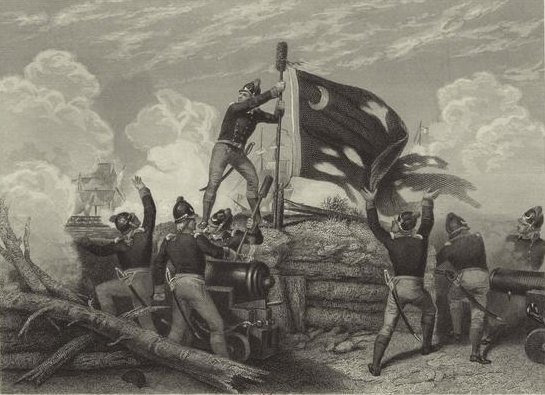
An historical image of Jasper raising the battle flag of the colonial forces over present-day Fort Moultrie on June 28, 1776 during the Battle of Sullivan’s Island.
S.C. Encyclopedia | In the aftermath of the battles at Lexington and Concord, the Continental Congress passed resolutions that created the Continental army in June 1775. Accordingly, a committee addressed the need for maintaining a regular army, and Congress began the task of apportioning quotas to the states. On November 4, 1775, Congress resolved to maintain “at the continental expense” three battalions for the defense of South Carolina. Continental regiments were units authorized for use by the Continental Congress and were distinct from state militia forces.
![]() The First Provincial Congress of South Carolina raised two regiments of infantry to protect the Lowcountry against the British and a third to protect the backcountry from potential Indian raids during the summer of 1775. The first two regiments, designated the First and Second State Regiments, were adopted by the Continental Congress as the First and Second South Carolina Regiments on September 20, 1776, retroactively dated November 4, 1775. The third unit, designated as a regiment of mounted riflemen, was also adopted retroactively into the Continental Line on November 12, 1775, and designated the Third South Carolina Regiment of Rangers.
The First Provincial Congress of South Carolina raised two regiments of infantry to protect the Lowcountry against the British and a third to protect the backcountry from potential Indian raids during the summer of 1775. The first two regiments, designated the First and Second State Regiments, were adopted by the Continental Congress as the First and Second South Carolina Regiments on September 20, 1776, retroactively dated November 4, 1775. The third unit, designated as a regiment of mounted riflemen, was also adopted retroactively into the Continental Line on November 12, 1775, and designated the Third South Carolina Regiment of Rangers.
The Second Provincial Congress of South Carolina authorized a fourth regiment, an artillery unit, on November 13, 1775, and two additional infantry regiments in late February 1776. Composed of three Charleston artillery companies, the Fourth South Carolina Regiment (Artillery) was placed on the Continental Establishment on June 18, 1776, and in October two independent artillery companies from Georgetown and Beaufort were added to its ranks. The Fifth and Sixth South Carolina Regiments, deemed Rifle Regiments, were adopted into the Continental Line on March 25, 1776.
Detachments from all South Carolina Continental Regiments participated in campaigns in South Carolina, Georgia, and Florida from the “Snow Campaign” in 1775 to the Siege of Charleston in the spring of 1780. The Second Regiment successfully defended against a naval bombardment while the Third Regiment prevented an amphibious assault on the eastern end of Sullivan’s Island on June 28, 1776. Additionally, all six units participated in the disastrous allied siege of Savannah in October 1779. With the exception of the Fifth and Sixth Regiments, which were consolidated with the First and Second Regiments in February 1780, all regiments of the South Carolina Continental Line were part of the American force that surrendered Charleston on May 12, 1780. Prominent members of the South Carolina Continental Line included Christopher Gadsden, William Moultrie, Francis Marion, Richard Richardson, and William Jasper.
List of Regiment Commanders
First S.C. Regiment
Col. Christopher Gadsden (June 17, 1775–Sept. 16, 1776)
Col. Charles Pinckney (Sept. 16, 1776–1780)
Second S.C. Regiment
Col. William Moultrie (June 17, 1775–Sept. 16, 1776)
Col. Isaac Motte (Sept. 16, 1776–1780)
Third S.C. Regiment (Mounted Rangers)
Lt. Col. William Thomson (June 17, 1775–1780)
Fourth S.C. Regiment (Artillery)
Lt. Col. Owen Roberts (Sept. 16, 1776–June 20, 1779)
Col. Barnard Beekman (June 20, 1779–1780)
Fifth S.C. Regiment (First S.C. Rifles)
Col. Isaac Huger (Sept. 17, 1776–Jan. 9, 1777)
Lt. Col. Alexander McIntosh (Jan. 1777–1780)
Sixth S.C. Regiment (Second S.C. Rifles)
Lt. Col. Thomas Sumter (Sept. 20, 1776–1780)
— Excerpted from an entry by Samuel K. Fore. This entry hasn’t been updated since 2006. To read more about this or 2,000 other entries about South Carolina, check out The South Carolina Encyclopedia, published in 2006 by USC Press. (Information used by permission.)



 We Can Do Better, South Carolina!
We Can Do Better, South Carolina!
























